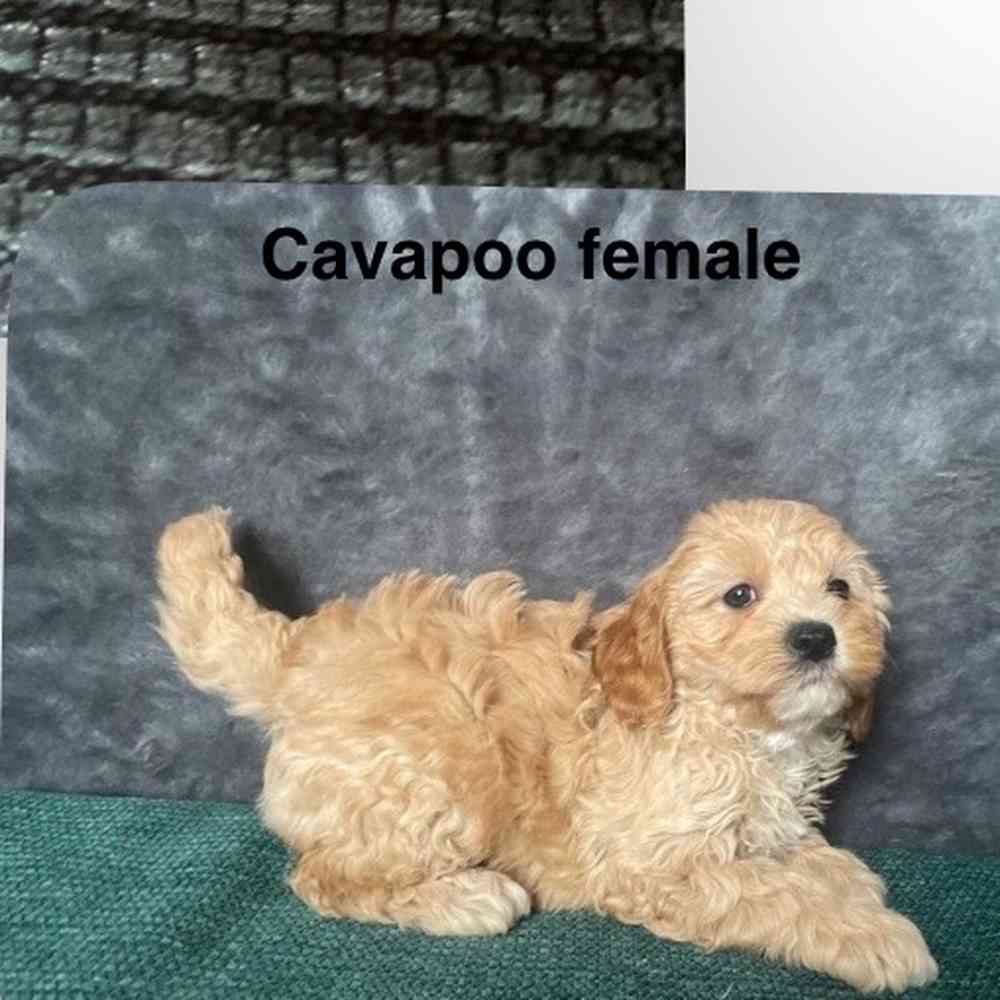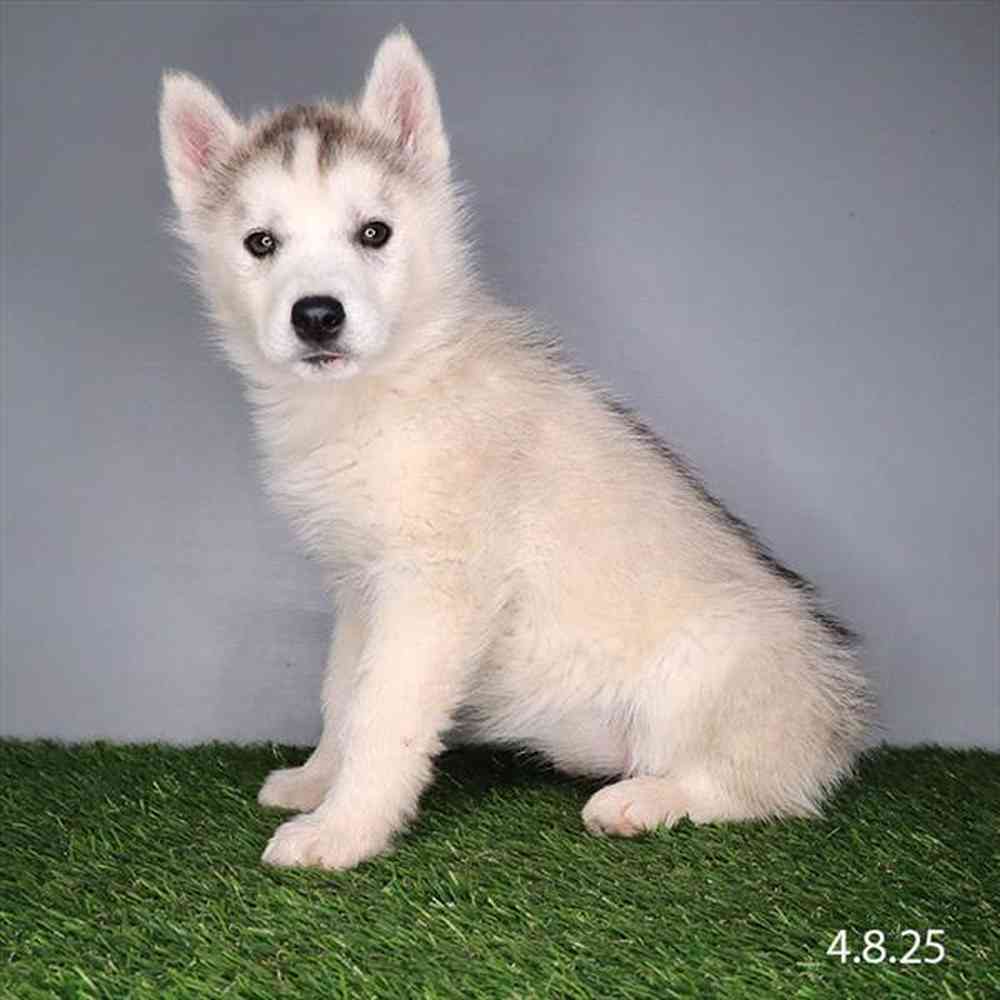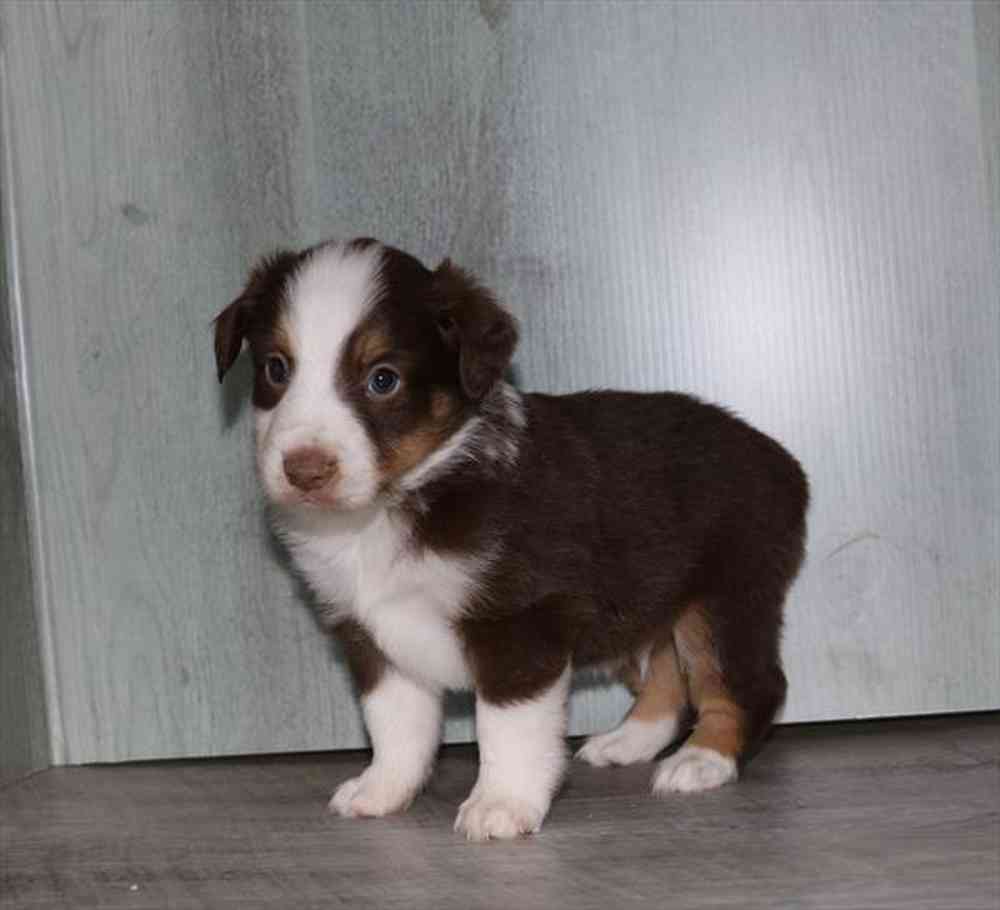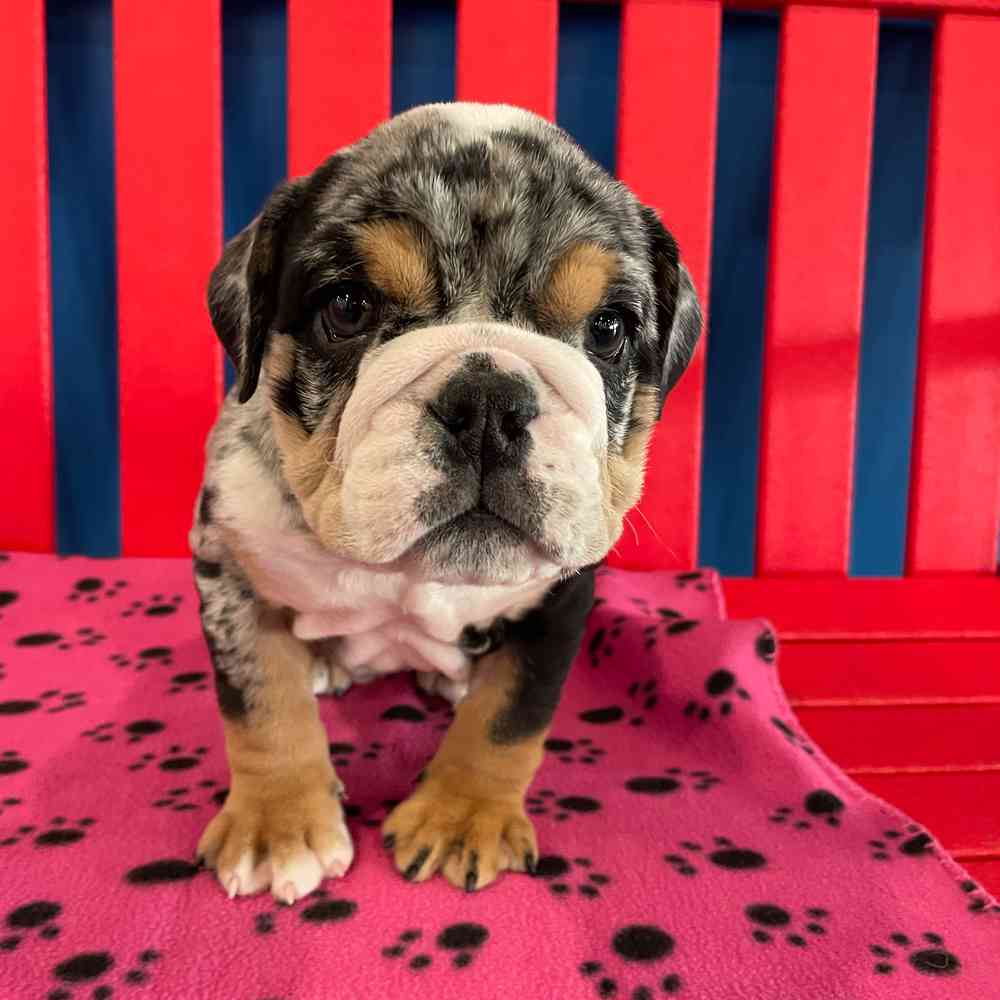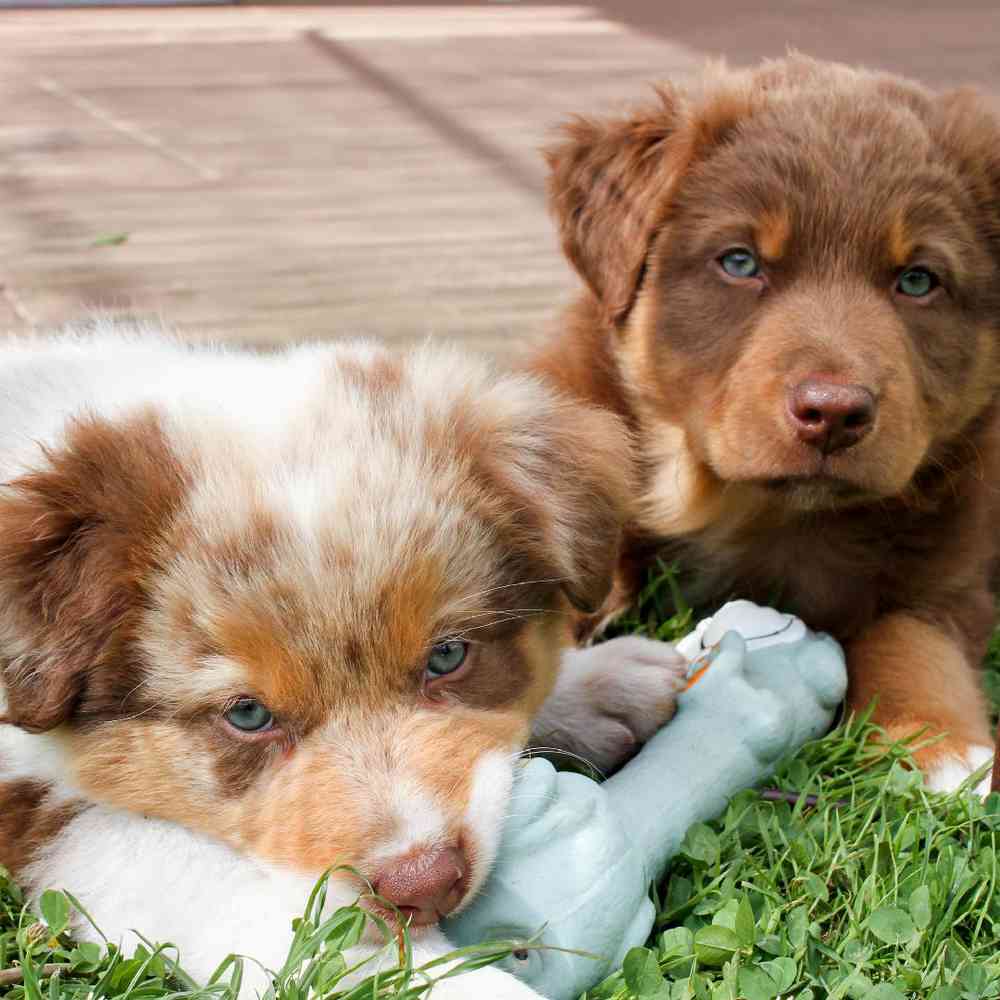
AKC Registrable
Guard Dog
Family Dog
Australian Shepherd
The Australian Shepherd, a lean, tough ranch dog, is one of those “only in America” stories: a European breed perfected in California by way of Australia. Fixtures on the rodeo circuit, they are closely associated with the cowboy life.
Available Pups
Breed Info
A Look Back
There are many theories about the origin of the Australian Shepherd. Despite its misleading name, the breed as we know it today probably developed in the Pyrenees Mountains somewhere between Spain and France. It was called the Australian Shepherd because of its association with Basque shepherds who came to America from Australia in the 1800s. The Australian Shepherd was initially called by many names, including Spanish Shepherd, Pastor Dog, Bob-Tail, Blue Heeler, New Mexican Shepherd, and California Shepherd.
History
The Australian Shepherd is descended from a line of Europe’s finest herders.The Aussie’s world tour began in Europe, near the Pyrenees Mountains. It was here, in the borderlands between France and Spain, where the indigenous people known as the Basques built their centuries-old reputation as world-class shepherds. Their herding dog of choice was called the Pyrenean Shepherd, progenitor of our modern Aussie. In the early 1800s, Australia’s Anglo émigrés began a push into the continent’s vast interior in search of rich pastureland for cattle ranching. Eventually, many Basques, with their faithful shepherd dogs in tow, sailed east to try their luck on the virgin Australian continent, a wide-open paradise for sheep herders. During their long sojourn in Australia, the Basque shepherd refined their dogs with judicious crosses to Australia’s British imports, Collies and Border Collies, among them. After building up their flocks, the intrepid Basques left Australia for greener pastures—literally—and set sail to California. California ranchers admired the Basques’ herding dogs and assumed they were an Australian breed—thus the misleading name Australian Shepherd. Aussies, further refined and perfected in America, have been an iconic part of cowboy culture ever since. Many are still happily herding in the American West, others earn their feed as rodeo performers, and still others of this exuberantly versatile breed work as therapy dogs, drug detectors, service dogs, and search-and-rescue dogs. The Australian Shepherd entered the AKC Herding Group in 1993.
Right Breed for You?
An energetic breed with strong herding and guarding instincts, the Aussie requires daily vigorous exercise. Although sometimes reserved with strangers, they are .people. dogs that want to always be near their families. Their thick coats require weekly brushing.
Breed Standard
General Appearance
The Australian Shepherd is an intelligent working dog of strong herding and guarding instincts. He is a loyal companion and has the stamina to work all day. He is well balanced, slightly longer than tall, of medium size and bone, with coloring that offers variety and individuality. He is attentive and animated, lithe and agile, solid and muscular without cloddiness. He has a coat of moderate length and coarseness. He has a docked or natural bobbed tail.
Size, Proportion, Substance
Size--The preferred height for males is 20-23 inches, females 18-21 inches. Quality is not to be sacrificed in favor of size. Proportion--Measuring from the breastbone to rear of thigh and from top of the withers to the ground the Australian Shepherd is slightly longer than tall. Substance--Solidly built with moderate bone. Structure in the male reflects masculinity without coarseness. Bitches appear feminine without being slight of bone.
Head
The Head is clean cut, strong and dry. Overall size should be in proportion to the body. The muzzle is equal in length or slightly shorter than the back skull. Viewed from the side the topline of the back skull and muzzle form parallel planes, divided by a moderate, well-defined stop. The muzzle tapers little from base to nose and is rounded at the tip. Expression --Showing attentiveness and intelligence, alert and eager. Gaze should be keen but friendly. Eyes are brown, blue, amber or any variation or combination thereof, including flecks and marbling. Almond shaped, not protruding nor sunken. The blue merles and blacks have black pigmentation on eye rims. The red merles and reds have liver (brown) pigmentation on eye rims. Ears are triangular, of moderate size and leather, set high on the head. At full attention they break forward and over, or to the side as a rose ear. Prick ears and hanging ears are severe faults. Skull Top flat to slightly domed. It may show a slight occipital protuberance. Length and width are equal. Moderate well-defined stop. Muzzle tapers little from base to nose and is rounded at the tip. Nose--Blue merles and blacks have black pigmentation on the nose (and lips). Red merles and reds have liver (brown) pigmentation on the nose (and lips). On the merles it is permissible to have small pink spots; however, they should not exceed 25% of the nose on dogs over one year of age, which is a serious fault. Teeth--A full complement of strong white teeth should meet in a scissors bite or may meet in a level bite. Disqualifications--Undershot. Overshot greater than 1/8 inch. Loss of contact caused by short center incisors in an otherwise correct bite shall not be judged undershot. Teeth broken or missing by accident shall not be penalized.
Neck, Topline, Body
Neck is strong, of moderate length, slightly arched at the crest, fitting well into the shoulders. Topline--Back is straight and strong, level and firm from withers to hip joints. The croup is moderately sloped. Chest is not broad but is deep with the lowest point reaching the elbow. The ribs are well sprung and long, neither barrel chested nor slab-sided. The underline shows a moderate tuck-up. Tail is straight, docked or naturally bobbed, not to exceed four inches in length.
Forequarters
Shoulders--Shoulder blades are long, flat, fairly close set at the withers and well laid back. The upper arm, which should be relatively the same length as the shoulder blade, attaches at an approximate right angle to the shoulder line with forelegs dropping straight, perpendicular to the ground. Legs straight and strong. Bone is strong, oval rather than round. Pastern is medium length and very slightly sloped. Front dewclaws may be removed. Feet are oval, compact with close knit, well arched toes. Pads are thick and resilient.
Hindquarters
The width of the hindquarters is equal to the width of the forequarters at the shoulders. The angulation of the pelvis and upper thigh corresponds to the angulation of the shoulder blade and upper arm, forming an approximate right angle. Stifles are clearly defined, hock joints moderately bent. The hocks are short, perpendicular to the ground and parallel to each other when viewed from the rear. Rear dewclaws must be removed. Feet are oval, compact with close knit, well arched toes. Pads are thick and resilient.
Coat
Hair is of medium texture, straight to wavy, weather resistant and of medium length. The undercoat varies in quantity with variations in climate. Hair is short and smooth on the head, ears, front of forelegs and below the hocks. Backs of forelegs and britches are moderately feathered. There is a moderate mane and frill, more pronounced in dogs than in bitches. Non-typical coats are severe faults.
Gait
The Australian Shepherd has a smooth, free and easy gait. He exhibits great agility of movement with a well-balanced, ground covering stride. Fore and hind legs move straight and parallel with the center line of the body. As speed increases, the feet (front and rear) converge toward the center line of gravity of the dog while the back remains firm and level. The Australian Shepherd must be agile and able to change direction or alter gait instantly.
Temperament
Smart, Work-Oriented, Exuberant
Color
Blue merle, black, red merle, red-all with or without white markings and/or tan (copper) points, with no order of preference. The hairline of a white collar does not exceed the point of the withers at the skin. White is acceptable on the neck (either in part or as a full collar), chest, legs, muzzle underparts, blaze on head and white extension from underpart up to four inches, measuring from a horizontal line at the elbow. White on the head should not predominate, and the eyes must be fully surrounded by color and pigment. Merles characteristically become darker with increasing age. Disqualifications White body splashes, which means white on body between withers and tail, on sides between elbows and back of hindquarters in all colors.
Disqualifications
Undershot. Overshot greater than 1/8 inch.White body splashes, which means white on body between withers and tail, on sides between elbows and back of hindquarters in all colors.
Overview
Group
Herding
About
The Australian Shepherd, the cowboy’s herding dog of choice, is a medium-sized worker with a keen, penetrating gaze in the eye. Aussie coats offer different looks, including merle (a mottled pattern with contrasting shades of blue or red). In all ways, they’re the picture of rugged and agile movers of stock. Aussies exhibit an irresistible impulse to herd, anything: birds, dogs, kids. This strong work drive can make Aussies too much dog for a sedentary pet owner. Aussies are remarkably intelligent, quite capable of hoodwinking an unsuspecting novice owner. In short, this isn’t the pet for everyone. But if you’re looking for a brainy, tireless, and trainable partner for work or sport, your search might end here.
Standard
The Australian Shepherd is an intelligent working dog of strong herding and guarding instincts. He is a loyal companion and has the stamina to work all day. He is well balanced, slightly longer than tall, of medium size and bone, with coloring that offers variety and individuality. He is attentive and animated, lithe and agile, solid and muscular without cloddiness. He has a coat of moderate length and coarseness. He has a docked or natural bobbed tail.
Nutrition
The Australian Shepherd should do well on a high-quality dog food, whether commercially manufactured or home-prepared with your veterinarian’s supervision and approval. Any diet should be appropriate to the dog’s age (puppy, adult, or senior). Some dogs are prone to getting overweight, so watch your dog’s calorie consumption and weight level. Treats can be an important aid in training, but giving too many can cause obesity. Learn about which human foods are safe for dogs, and which are not. Check with your vet if you have any concerns about your dog’s weight or diet. Clean, fresh water should be available at all times.
Grooming
In general, weekly brushing sessions will keep the Australian Shepherd’s waterproof, double-layer coat looking its best. During shedding season, though, more work will be required. During this period an undercoat rake can be used every two or three days to remove the abundant dead hair, followed by a cleanup with the wire brush. Aussies often work and/or play outdoors, so it’s not unusual for them to come in dirtier than they left. But unless they’ve gotten into a particularly messy situation, they require a bath only occasionally. As with all breeds, the Aussie‘s nails should be trimmed regularly.
Exercise
A high-energy, athletic dog, the Aussie needs a great deal of exercise on a daily basis. At minimum, he should have a large, fenced-in yard to run around in for at least an hour or two daily. Aussies bond closely with their owners and love to accompany them on long walks—or, better yet, hikes. Once an Aussie leaves puppyhood behind, and his skeletal system is fully formed, he can make a great running companion. The best course, however, is to give the Aussie a job, whether that is herding livestock, shepherding children, or competing in canine events such as obedience, herding or agility trials, or dock diving.
Training
Early socialization and obedience training are both musts for the Australian Shepherd. One of the most frequent reasons Aussies end up in rescue situations is owners couldn’t (or wouldn’t) constructively channel the breed’s boundless energy through training. Aussies bond strongly to their families and so can be territorial and overprotective of their owners’ property, and they can become destructive if left without companionship for long periods too often. Fortunately, that loyalty combined with the breed’s keen intelligence and high energy makes them very easy to train.
Health
Aussies are generally healthy dogs, and a responsible breeder will test breeding stock for health concerns such as hip dysplasia, epilepsy, cataracts and certain forms of cancer. An Aussie’s ears should be checked regularly to remove foreign matter and avoid a buildup of wax, and his teeth should be brushed regularly.
Trivia
Did you know?
The Australian Shepherd is AKC's 135th breed.The Aussie as we know it today developed in the US.The Aussie probably originated in the Basque region of the Pyrenees Mountains, but it was dubbed the Australian Shepherd because of its association with Basque shepherds who arrived in the United States from Australia in the 1800's.Previous names of the Aussie include Spanish Shepherd, Pastor Dog, Bob-Tail, Blue Heeler, New Mexican Shepherd, and California Shepherd.The Aussie's popularity boomed with Western culture and horse-riding after WWII and was often featured in rodeos, horse shows, movies, and TV.TheAussie is a favorite of ranchers, who use the breed for its inherent trainability and herding ability. It is a loose- to medium-eyed dog ("eye" being a general term referring to the way a dog controls stock via gaze).The Australian Shepherd is not registered in Australia as a native breed, although it has been registered by other registries since the 1950's.




